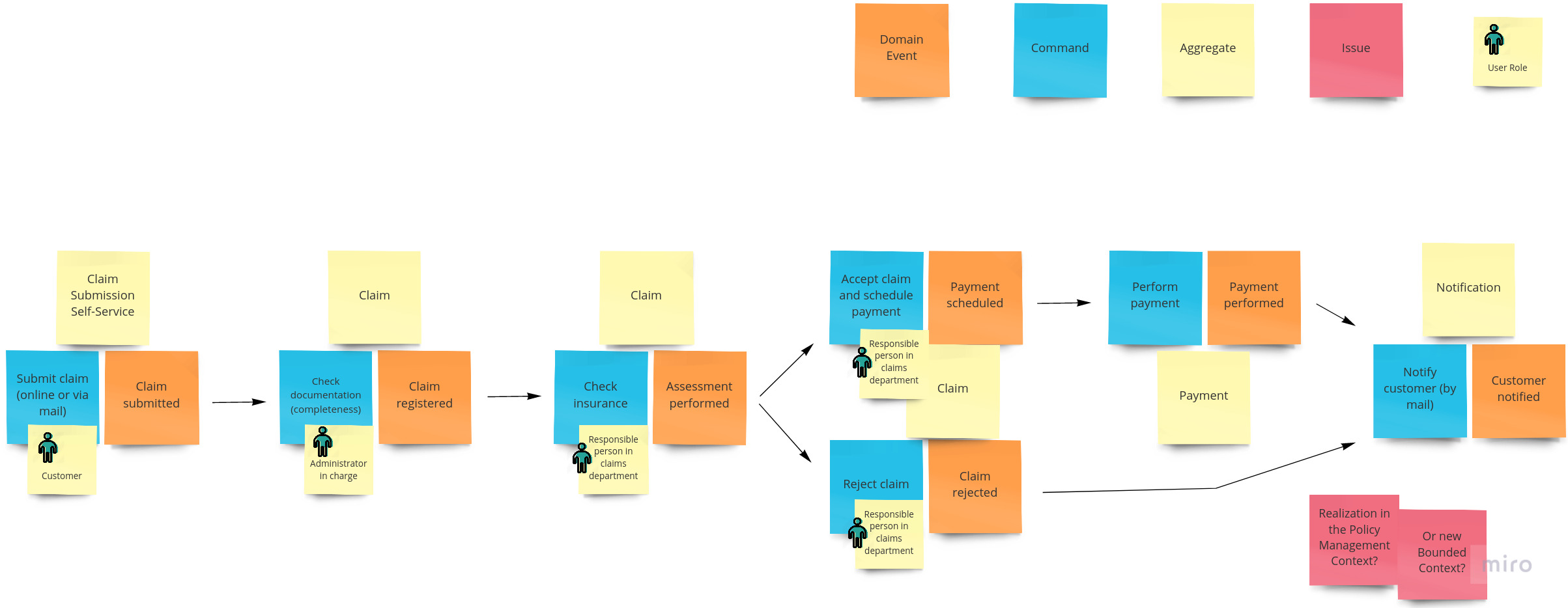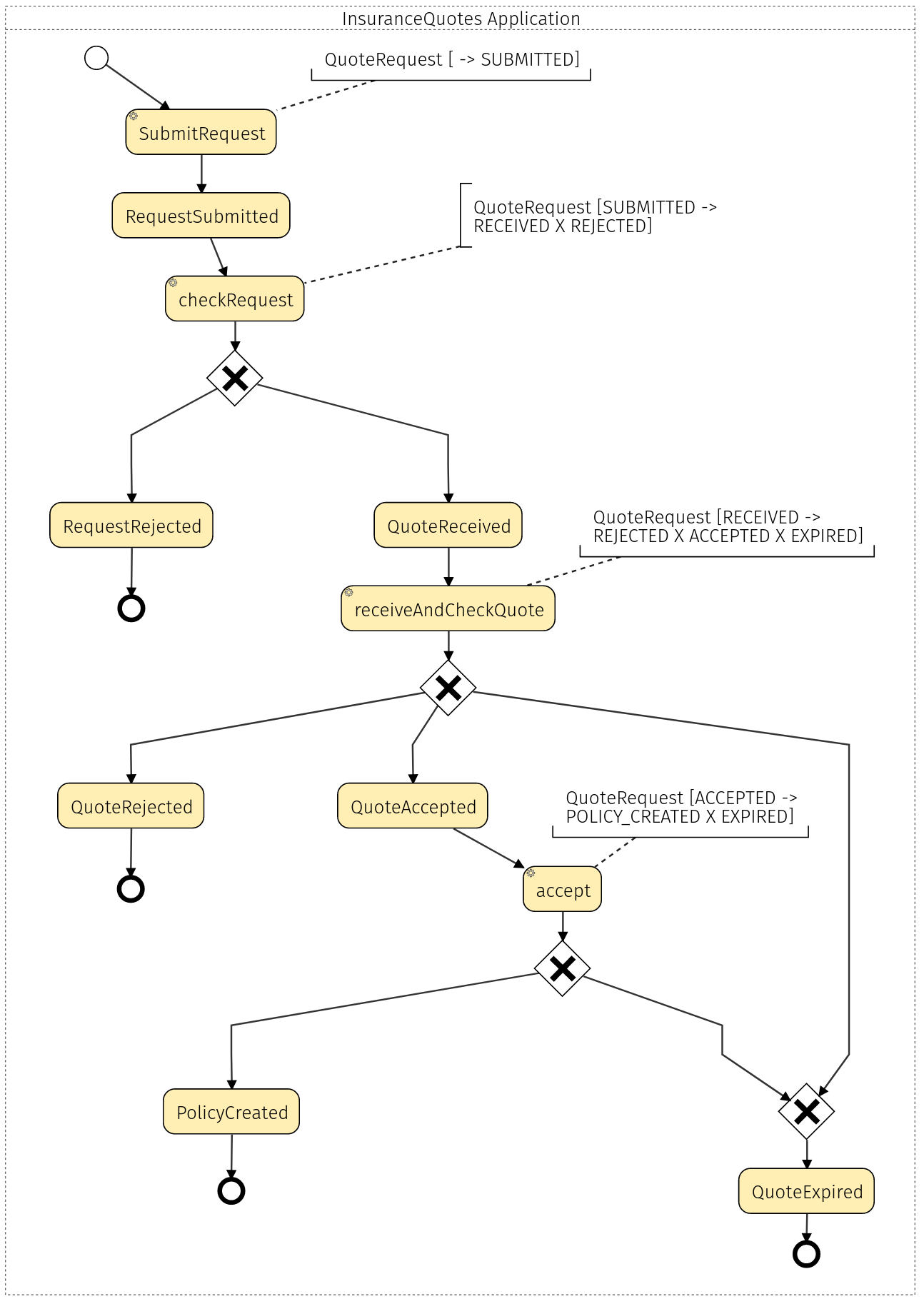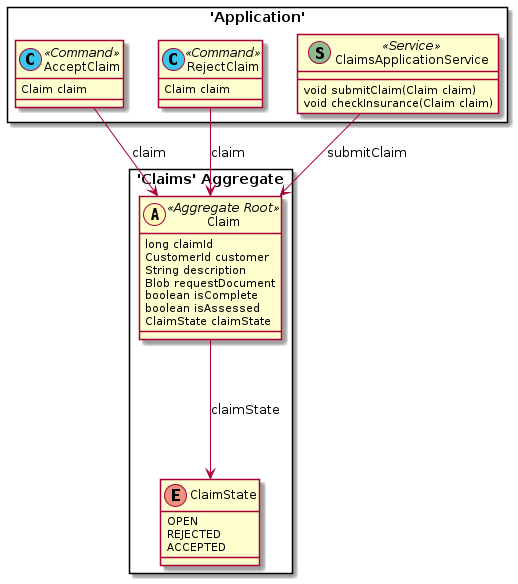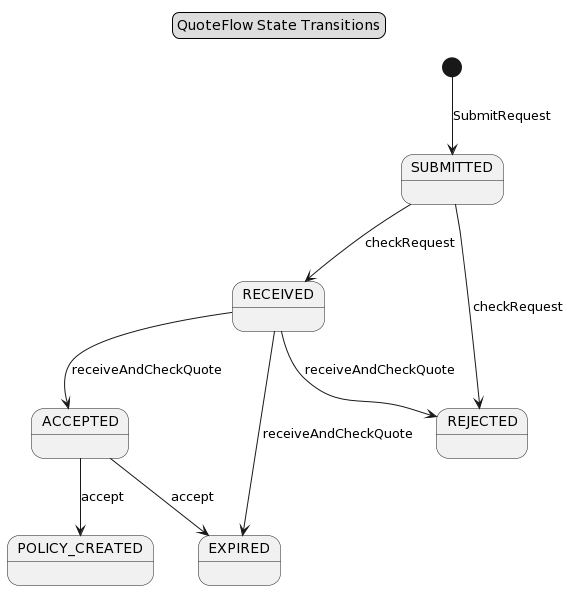Recent News
- Aug 30, 2024v6.12.0 - Stakeholder and Value Modelling Support
- Jan 11, 2024v6.11.0 Release Notes
- Nov 24, 2023v6.10.0 Release Notes
- Aug 16, 2023v6.9.0 Release Notes
- Jun 13, 2023Eclipse Update Site URL Changed
- May 8, 2023v6.8.0 Release Notes
- Dec 2, 2022v6.7.0 Release Notes
- Oct 6, 2021v6.6.0 Release Notes
- May 31, 2021ArchUnit Extension for Context Mapper Released
- May 8, 2021Eclipse Update Site URL Changed
- All news ...
v6.2.0 Release Notes
Dec 17, 2020 • Stefan Kapferer
Today we released version 6.2.0 of Context Mapper 🥳
This new Context Mapper version introduces new CML language features to model application layers with application services and commands, event/command flows (potentially as a result of an Event Storming), and the lifecycle of Aggregates. We further added a generator that visualizes the event flows powered by BPMN Sketch Miner and enhanced the PlantUML generator with state diagrams. The MDSL generator as well as the PlantUML class diagram generator have been enhanced to support the new application layer and flow features. Last but not least, this release contains a “proof of concept” for automated model transformations that support Story Splitting.
Summary of Changes
- Aggregate Lifecycle and State Transitions
- Application Layer and Event Flows
- BPMN Sketch Miner Generator
- PlantUML Generator Adjustments
- MDSL Generator Adjustments
- Story Splitting (PoC)
- Semantic Validator Changes
As always, if you have any issues or other feedback, please let us know.
Aggregate Lifecycle and State Transitions
The CML syntax can express the states of Aggregates now. States are defined as enums marked as follows:
Aggregate Contract {
Entity Contract {
aggregateRoot
- State aggregateState
- ContractId identifier
- Customer client
- List<Product> products
}
enum State {
aggregateLifecycle
CREATED, POLICE_CREATED, RECALLED
}
}
Users can then specify whether an operation is a read-only or a write operation. For write operations, the state transition that the operation performs (supported on operations in services or domain objects such as entities) can be defined as well:
Service ContractService {
@ContractId createContract(@Contract contrace) : write [ -> CREATED];
@Contract getContract(@ContractId contractId) : read-only;
boolean createPolicy(@ContractId contractId) : write [ CREATED -> POLICE_CREATED ];
boolean recall(@ContractId contractId) : write [ CREATED, POLICE_CREATED -> RECALLED ];
}
More details about the new syntax for Aggregate lifecycles and state transitions can be found here on the Aggregate page of the language reference.
Application Layer and Event Flows
DDD distinguishes between domain services and application services. Inside a Bounded Context you can now model an application layer in CML. Such an application layer can contain application services and commands that are initiated by users or external systems:
BoundedContext ClaimsManagement {
Application {
Service ClaimsApplicationService {
void submitClaim(@Claim claim);
void checkInsurance(@Claim claim);
}
Command AcceptClaim {
- Claim claim
}
Command RejectClaim {
- Claim claim
}
}
Aggregate Claims {
Entity Claim {
aggregateRoot
long claimId
CustomerId customer
String description
Blob requestDocument
boolean isComplete
boolean isAssessed
- ClaimState claimState
}
enum ClaimState {
aggregateLifecycle
OPEN, REJECTED, ACCEPTED
}
}
}
In addition to that, the application layer can contain event/command flows. They can be used to model processes and bring events and commands into a timeline (for example as a result of an Event Storming).
An example:
Application {
/* we removed commands and events here to keep the sample shorter */
Flow ClaimsFlow {
command SubmitClaim emits event ClaimSubmitted
event ClaimSubmitted triggers command CheckClaimDocumentation
command CheckClaimDocumentation emits event ClaimRegistered
event ClaimRegistered triggers command CheckInsurance
command CheckInsurance emits event AssessmentPerformed
event AssessmentPerformed triggers command AcceptClaim X RejectClaim
command AcceptClaim delegates to Claims [OPEN -> ACCEPTED] emits event ClaimAccepted
command RejectClaim delegates to Claims [OPEN -> REJECTED] emits event ClaimRejected
event ClaimAccepted triggers command SchedulePayment
command SchedulePayment emits event PaymentPerformed
event PaymentPerformed triggers command NofifyCustomer
event ClaimRejected triggers command NofifyCustomer
command NofifyCustomer delegates to Claims [ACCEPTED, REJECTED -> CUSTOMER_NOTIFIED] emits event CustomerNotified
}
}
In this case the modeled flow is based on the output of our Event Storming tutorial:
Checkout our Application and Process Layer language reference page for more details.
BPMN Sketch Miner Generator
The BPMN Sketch Miner generator visualizes the CML event/command flows introduced above powered by the BPMN Sketch Miner tool.
We modeled the following CML flow, as another example:
/**
* A flow inspired by the Lakeside Mutual project (https://github.com/Microservice-API-Patterns/LakesideMutual).
* Find the original process visualization here:
* https://github.com/Microservice-API-Patterns/LakesideMutual/blob/master/policy-management-backend/src/main/java/com/lakesidemutual/policymanagement/domain/insurancequoterequest/RequestStatus.java
**/
BoundedContext InsuranceQuotes {
Application {
Flow QuoteRequestFlow {
operation submitRequest delegates to QuoteRequest[-> SUBMITTED] emits event RequestSubmitted
event RequestSubmitted + RequestSubmitted triggers operation checkRequest
operation checkRequest delegates to QuoteRequest[SUBMITTED -> RECEIVED X REJECTED] emits event QuoteReceived X RequestRejected
event QuoteReceived triggers operation receiveAndCheckQuote
operation receiveAndCheckQuote delegates to QuoteRequest[RECEIVED -> REJECTED X ACCEPTED X EXPIRED] emits event QuoteRejected X QuoteAccepted X QuoteExpired
event QuoteAccepted triggers operation accept
operation accept delegates to QuoteRequest[ACCEPTED -> POLICY_CREATED X EXPIRED] emits event PolicyCreated X QuoteExpired
}
}
Aggregate QuoteRequest {
Entity Request {
aggregateRoot
}
DomainEvent RequestSubmitted
DomainEvent QuoteReceived
DomainEvent RequestRejected
DomainEvent QuoteRejected
DomainEvent QuoteAccepted
DomainEvent QuoteExpired
DomainEvent PolicyCreated
Service QuoteRequestService {
void submitRequest(@Request request);
void checkRequest(@Request request);
void receiveAndCheckQuote(@Request request);
void reject(@Request request);
void accept(@Request request);
}
enum RequestState {
aggregateLifecycle
SUBMITTED, RECEIVED, REJECTED, ACCEPTED, EXPIRED, POLICY_CREATED
}
}
}
By using this generator users can visualize this flow quickly and get the following output:
(powered by BPMN Sketch Miner)
More details on this generator and how to use it can be found on the BPMN Sketch Miner Generator page.
PlantUML Generator Adjustments
The PlantUML class diagram generator has been enhanced so that services and commands of the application layer are respected as well. An example output:
In addition to that, the generator now produces state diagrams that visualize the Aggregate lifecycles introduced above: (in case you modeled the corresponding states and state transitions)
MDSL Generator Adjustments
The MDSL generator has been enhanced as follows:
- A new endpoint is generated for the application layer.
- The endpoint contains the operations of the application services and/or commands.
- Events and/or commands that are used as parameters or return types of operations in CML are now properly mapped to corresponding data types in MDSL.
Story Splitting (PoC)
With our story splitting proof-of-concept (PoC) we offer a first model transformation that can split a CML user story. We only implemented one exemplary transformation for now, but other splitting patterns could be supported in the future. This first PoC provides a transformation that can “split a story by its verb” quickly.
For example, a user may write the following user story in CML:
UserStory Account_Admin_Story {
As an "Admin" I want to "manage" an "Account" so that "can enable users to work with the system."
}
By providing verbs to split the story, for example create, edit, and cancel, you can split this story very quickly: (one click and typing the verbs)
UserStory Account_Admin_Story split by Account_Admin_Story_Split {
As an "Admin" I want to "manage" an "Account" so that "can enable users to work with the system."
}
UserStory Account_Admin_Story_Split {
As an "Admin"
I want to "cancel" an "Account"
I want to "edit" an "Account"
I want to create an "Account"
so that "can enable users to work with the system."
}
You can find more details on how you can use this transformation on our documentation page.
Semantic Validator Changes
- Domain names must be unique now (duplicate domain names no longer compile in CML models).
- A subdomain can no longer have the same name as its domain.
Summary
That’s it for this new release of Context Mapper. As always, if you have any issues or other feedback, please let us know.



